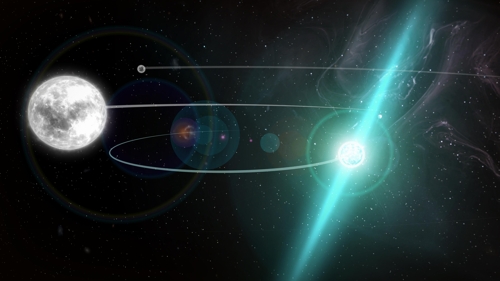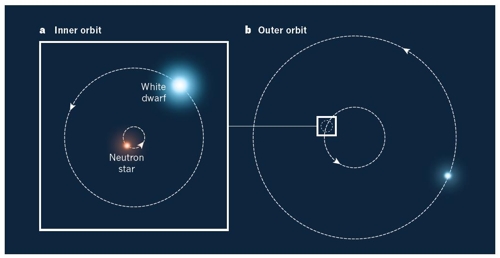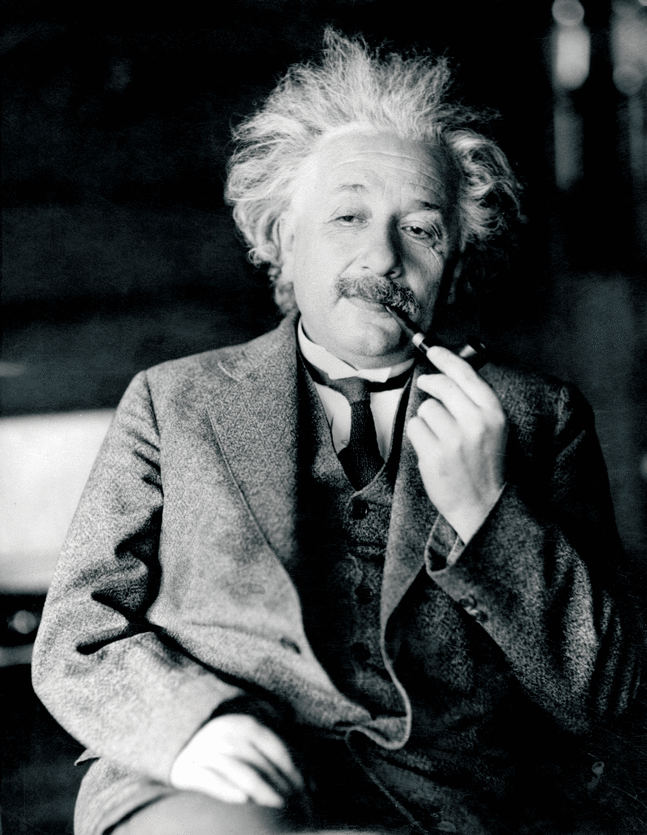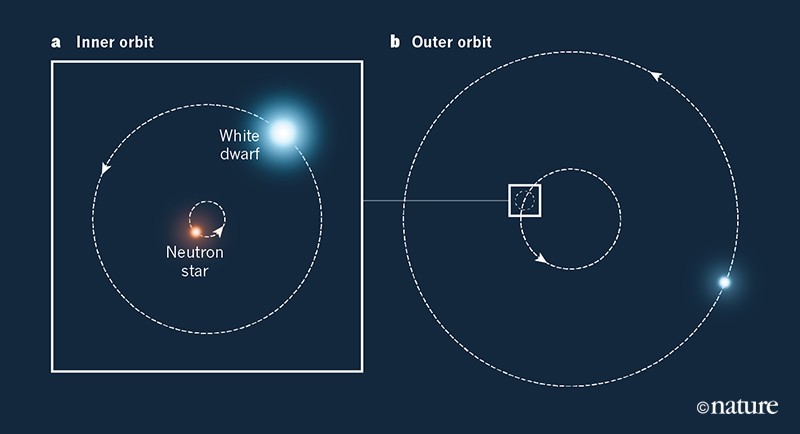(원문)
국제공동연구진 “삼중성계 관측 통해 일반상대성이론 등가원리 확인”
아인슈타인의 일반상대성이론(general theory of relativity)이 또 하나의 엄정한 시험대를 통과했다.
네덜란드 전파천문학연구소 앤 아치볼드 박사가 이끄는 국제공동연구팀은 5일 국제학술지 ‘네이처'(Nature)에서 지구에서 4천200광년 떨어진 곳에 있는 중성자별과 백색왜성 2개로 이루어진 삼중성계를 정밀 관측, 중력이 극도로 큰 천체들의 상호작용 속에서도 일반상대성이론이 정확히 작동한다는 사실을 확인했다고 밝혔다.

일반상대성원리 검증에 이용된 삼중성계 상상도지구에서 4천200광년 떨어진 곳에 있는 삼중성계(PSR J0337+1715). 오른쪽 푸른 빛을 내는 천체가 중성자별, 왼쪽의 큰 흰색 천체가 중성자별 주위를 1.6일에 한 바퀴씩 돌고 있는 백색왜성, 백색왜성 오른쪽 위의 작은 별이 바깥 멀리에서 안쪽의 중성자별과 백색왜성을 327일에 한 바퀴씩 돌고 있는 바깥쪽 백색왜성. [NRAO/AUI/NSF 제공=연합뉴스]
네이처는 이 결과에 대해 “모든 물체는 자체 중력과 관계없이 극한의 중력장 속에서 낙하할 때 동일한 가속도를 갖는다는 일반상대성이론의 등가원리(equivalence principle)가 지금까지 행해진 것 중 가장 엄중한 테스트를 통과했다”고 전했다.
일반상대성이론의 등가원리는 피사의 사탑에서 포탄과 사과를 떨어뜨리면 동시에 땅에 떨어지는 것처럼 모든 낙하하는 물체는 자체 질량이나 구성, 외부 중력의 영향 등과 관계없이 똑같이 가속도를 받는다고 설명한다.
학계에서는 이 원리가 대부분 성립한다고 보고 있지만 일부에서는 중력이 극도로 큰 극한 중력장 속에서는 일반상대성이론과 다른 중력이론이 작동할 수 있다는 가설들도 제기해 왔다.
연구진은 2011년 발견한 지구에서 4천200광년 떨어진 곳에 있는 삼중성계(PSR J0337+1715)를 6년여에 걸쳐 정밀 관측해 극한 중력장 속에서도 일반상대성이론이 정확히 적용된다는 결과를 얻었다.

삼중성계 PSR J0337+1715의 궤도 [네이처 논문 캡처=연합뉴스]
이 삼중성계는 중심에 초당 366회씩 회전하는 중성자별이 있고 그 주위를 백색왜성이 1.6일에 한 바퀴씩 돌고 있다. 바깥쪽 먼 곳에서는 또 하나의 백색왜성이 가운데의 두 별을 327일에 한 바퀴씩 회전하고 있다.
백색왜성은 크기는 지구와 비슷하지만 밀도가 매우 커 질량은 우리 태양과 맞먹는다. 중성자별은 크기는 백색왜성보다 작지만 밀도는 훨씬 커 중력도 매우 크다. 이런 별들은 별이 생명을 마칠 때 초신성폭발을 일으키면서 중심핵이 붕괴해 만들어진다.
연구진은 6년여 동안 네덜란드 웨스터보크 합성 전파망원경, 웨스트버지니아의 그린 뱅크 망원경, 푸에르토리코의 아레시보 전파망원경으로 각각 매우 큰 중력을 가진 중성자별과 안쪽과 바깥쪽 백색왜성이 서로 어떻게 영향을 미치는지 관측, 극한 중력장 속에서도 일반상대성이론이 작동하는지 검증했다.
그 결과 바깥쪽 백색왜성이 안쪽의 중성자별과 백색왜성에 미치는 중력의 영향 차이가 최대 260만분의 1 이하로 거의 차이가 없음을 확인했다.
네이처는 이 결과는 이전에 수행된 등가원리 검증을 1천배 정도 향상함으로써 아인슈타인의 일반상대성 이론이 옳다는 것을 뒷받침하고 있다고 설명했다.
남순건 경희대 물리학과 교수는 “극한적인 중력 환경에서도 일반상대성이론의 등가원리가 확고하게 검증됐다는 데 의미가 있다”며 “일반상대성이론이 빅뱅이나 블랙홀 같은 더 극한적인 상황에서는 깨지는 경우가 나오겠지만 이번 연구로 이 이론에 대한 믿음은 더 커지게 됐다”고 말했다.
General relativity verified by a triple-star system
(원문: 여기를 클릭하세요~)
Einstein’s theory of gravity — the general theory of relativity — is based on the principle that all objects accelerate identically in an external gravitational field. A triple-star system provides a stringent test of this principle.
All bodies in a given gravitational field are thought to fall with the same acceleration. This idea, known as the equivalence principle, is central to our understanding of gravitational physics. It was promoted by thinkers ranging from the sixth-century scholar John Philoponus to Galileo; it is the founding principle of Albert Einstein’s general theory of relativity, and was famously demonstrated when Apollo astronaut David Scott dropped a hammer and a feather on the Moon and saw that they hit the lunar surface at the same time. For decades, experimentalists have verified the equivalence principle using exquisitely delicate instruments. Now, in a paper in Nature, Archibald et al.1 report the results of a remarkable test of the principle, in which the falling objects are two stellar remnants: a neutron star and a white dwarf.
In 2014, astronomers reported a pulsar that is unusual because it has two stellar companions2 (Fig. 1). The neutron star, weighing 1.4 solar masses, is in a close 1.6-day orbit with a 0.2-solar-mass white dwarf. This pair of objects is itself in a 327-day orbit with a 0.4-solar-mass white dwarf. The inner and outer orbits are nearly circular and exist in almost exactly the same plane.
Figure 1 | Triple-star system. In 2014, astronomers reported a system that contains three stellar remnants: a neutron star and two white dwarfs2. a, The neutron star is in a close 1.6-day orbit with one of the white dwarfs. b, This pair of objects is itself in a 327-day orbit with the other white dwarf. Archibald et al.1 report no evidence of a deformation of the inner orbit, which would be expected if there were a difference between the accelerations of the neutron star and the inner white dwarf towards the outer white dwarf. The results provide support for Einstein’s theory of gravity — the general theory of relativity.
If the neutron star and the inner white dwarf were to fall with different accelerations towards the outer white dwarf, there would be a tiny deformation of the inner orbit. Archibald and colleagues report an analysis of approximately six years of data showing no evidence of such a deformation. The accelerations of the two bodies differ by no more than 2.6 parts per million, in agreement with the equivalence principle.
Tests of this principle have a long heritage. In the late nineteenth century, the Hungarian physicist Roland von Eötvös devoted years to verifying that the accelerations of various laboratory materials in Earth’s gravitational field differ by less than a few parts per billion3. His modern-day successors, the Eöt-Wash group4 in Seattle, Washington, pushed this bound to parts per 1013. And, in 2017, data from the French space mission MICROSCOPE5 moved the goalpost by a further factor of ten.
Given that a typical object in a physics lab consists of a swarm of elementary particles and their associated fields and energies, it is quite extraordinary that the responses of different materials to gravity should be so similar. In Einstein’s unique imagination, there was a reason: gravity is not a force that acts on all of these particles in some fantastically fine-tuned manner, but is simply an effect of space-time geometry. The constituents of matter follow universal paths in a space-time that is curved by massive bodies, such as Earth or the Sun.
But does gravitational energy act in the same way as matter? The small objects used in lab experiments do not contain enough gravitational energy to answer this question, but planets and stars do. With self-gravity in the picture, a concept called the strong equivalence principle comes into play. This principle singles out the general theory of relativity from its competitors. In Einstein’s theory, all bodies — hammers, feathers, planets, neutron stars, white dwarfs and even black holes — fall with the same acceleration. But in most alternative theories of gravity, such as scalar–tensor theories6, the equivalence principle is violated for bodies that have self-gravity.
For almost 50 years, researchers have measured how long it takes for laser pulses to make the round trip from Earth to the Moon and back — a technique known as lunar laser ranging. Analyses of these data7,8 have verified the strong equivalence principle, by showing that the accelerations of the two bodies towards the Sun differ by no more than a few parts per 1013. Because about 5 parts in 1010 of Earth’s mass is gravitational energy9, this result implies that the accelerations of gravitational energy and matter differ by less than a few parts per 104.
Archibald and colleagues’ study breaks new ground because the gravitational energy inside a neutron star can account for as much as 20% of the body’s mass10. The authors’ results therefore imply that the accelerations of gravitational energy and matter differ by no more than a few parts per 105 — a tenfold improvement over the bound from lunar laser ranging.
More importantly, the authors have provided what is known as a strong-field test of general relativity. Unlike the Solar System, for which Einstein’s theory predicts only small deviations from Newton’s theory of gravity, the motion of a neutron star in a gravitational field invokes full general relativity in all its complex glory. Einstein’s theory passes this strong-field test with flying colours.
Because general relativity predicts a null effect, the grading is a simple pass or fail. But for alternative theories, invoking strong-gravity effects substantially complicates the interpretation of the results. Archibald et al. demonstrate this complexity using scalar–tensor theories as an example. For these theories, the interpretation of the results depends on the internal structure assumed for the neutron star and on the values chosen for quantities known as coupling constants. The authors show that their results improve on certain pre-existing constraints on the parameters that govern these theories — some arising from Solar System measurements and some from data on binary systems containing a pulsar. Although the theories are not completely quashed, their hopes for validity have been made that much fainter.
Nature 559, 40-41 (2018)
아래는 2023년 7월 20일 뉴스입니다~
(원문: 여기를 클릭하세요~)
아인슈타인 이론 또 증명…빅뱅 10억년 후 ‘시간 지연’ 포착

지구에서 관측할 수 있는 가장 먼 거리의 천체이자 초거대 질량의 블랙홀인 퀘이사. photo 뉴시스
아인슈타인의 ‘시간 지연(time dilation)’을 뒷받침할 흔적이 초기 우주에서 실제로 관측돼 화제다. 빅뱅 발생 이후 10억년 지난 우주의 시간이 지금에 비해 5배 느리게 흘렀다는 사실이 관측된 것이다.
시간 되돌리니 5배 느리게 흘러
‘시간 팽창’으로도 불리는 시간 지연은 아인슈타인의 특수상대성 이론과 일반상대성 이론에 따른 현상이다. 아인슈타인은 1905년 특수상대성 이론과 1915년 일반상대성 이론을 발표하며 상대적인 시간 기준계 모델을 제시했다. 특수상대성 이론에 따르면 ‘움직이는 물체의 시간은 느리게 간다’. 여기서 중요한 전제가 있다. 관측자가 정지 또는 등속일 때만 적용 가능한 이론이다. 말 그대로 특수한 상황에서의 이론이다.
일반상대성 이론에 따르면 ‘중력장은 시간의 흐름을 늦춘다’. 강한 중력이 시공간을 휘게 하여 시간 지연을 유발한다는 것이다. 특수상대성 이론과 달리 일반상대성 이론에서는 관측자가 정지, 등속일 때를 포함하여 가속 운동하는 모든 상황까지도 적용 가능하다.
두 상대성 이론을 종합하면, ‘시간 지연’은 시공간의 구조 변화에 따른 것으로 관측자의 운동 상태나 중력의 크기에 따라 어떤 두 사건 사이의 시간 간격이 다르게 측정되는 것을 말한다. 운동 속도가 빠를수록(빛의 속도와 가까워질수록), 중력이 클수록 시간이 상대적으로 느리게 흐르는 현상이다. 이 발견은 인류 과학사에서 가장 유명한 사건이 되었다.
상대성 이론의 시간 지연은 지구에서 멀리 떨어진 초기 우주일수록 그 현상이 더 잘 드러난다. 그러나 현재를 살아가는 우리가 이렇게 먼 과거의 우주 시간을 관측하기란 쉽지 않다. 이전까지 천문학자들은 시간 지연을 연구할 때 초신성을 ‘표준시계’로 활용했다. 초신성은 수명을 다한 거대한 별이 최후에 폭발하는 현상으로, 폭발 때 엄청난 에너지를 내뿜기 때문에 매우 밝다. 그럼에도 초기 우주를 들여다보는 데 필요한 먼 거리의 관측은 어렵다.
이에 호주 시드니대 물리학과 게라인트 루이스 교수와 뉴질랜드 오클랜드대 통계학과 브랜던 브루어 교수 연구팀은 지난 20년간 기록된 190개의 퀘이사(Quasar) 관측 데이터를 정밀 분석해 이 문제를 해결했다. 퀘이사 관측은 각각의 퀘이사에서 나오는 녹색광, 적색광, 적외선 등 서로 다른 3개의 파장에서 이뤄져 있었다. 연구팀은 이를 모두 결합해 분석해보았다. 그랬더니 파장의 모양을 표준화해 시계처럼 활용하는 게 가능했다. 즉 퀘이사의 점멸(ticking) 현상을 표준화해 ‘표준시계’를 만들 수 있었다.
퀘이사는 지구에서 관측할 수 있는 가장 먼 거리의 천체이자 초거대 질량의 블랙홀이고, 강한 에너지를 방출하는 활동 은하다. 전파뿐 아니라 거의 모든 전자기파 대역에서 매우 강한 에너지를 낸다. 그 때문에 수십억 광년 떨어져 있는데도 마치 별처럼 밝게 보인다.
루이스 교수는 “초신성은 밝고 단일 섬광처럼 움직여 연구하기가 쉽지만, 퀘이사는 불꽃놀이처럼 복잡하다. 우리는 이 불꽃놀이를 분석해 퀘이사도 초기 우주의 표준시간 지표로 사용될 수 있음을 확인했다”며 표준시간 활용에 큰 만족감을 나타냈다.
표준시계는 관측 시점에 따라 우주의 시간이 얼마나 빠르게 흘렀는지 확인할 수 있는 기준으로 활용했다. 연구팀은 표준시계를 빅뱅이 일어난 후 10억년이 흐른 시점으로 되돌렸다. 그 결과 138억년 전 우주의 시초인 빅뱅이 발생한 뒤 10억년이 흐른 우주에서는 시간이 현재보다 5배쯤 느리게 가는 것으로 확인됐다. 이는 아인슈타인이 지적한 ‘시간 지연’ 현상이 발생했기 때문으로 풀이된다. 루이스 교수는 “여러분이 만약 이 초기 우주에 있다면 1초가 1초처럼 느껴지겠지만, 120억년이 지난 미래의 우리 입장에서는 그 초기 시간이 길게 느껴질 것이다”라는 말로 시간 지연을 설명했다.

생전의 아인슈타인. photo 뉴시스
시간 지연, 30㎝ 높이에서도 일어난다
이보다 앞서 이뤄진 연구팀의 퀘이사 관측 연구에서는 시간 지연을 확인하지 못했다. 이번과 대조되는 결과로 인해 우주 팽창에 대한 많은 의문이 풀리지 않은 상태였다. 하지만 새로운 데이터 분석 결과는 이 같은 의문을 말끔히 씻어내기에 충분했다.
루이스 교수는 “아인슈타인 덕분에 우리는 시간과 공간이 얽혀 있고, 빅뱅이 시작된 특이점으로부터 우주가 팽창하고 있다는 것을 알게 됐다”며 “이런 공간 팽창은 초기 우주를 관측할 때 현재보다 시간이 훨씬 느리게 흐르는 것으로 관측돼야 한다는 것을 의미한다”고 말했다.
이어 그는 “우리는 그것을 증명하기 위해 빅뱅이 일어난 후 10억년이 지난 초기 우주 은하의 퀘이사를 분석했고, 그 결과 아인슈타인의 예측대로 지금보다 시간이 5배 느리게 가는 지연 현상을 발견하게 됐다”고 연구 결과를 설명했다. 연구팀은 우주가 나이를 먹음에 따라 시간이 흐르는 속도도 점점 빨라진다는 것도 확인했다. 이들의 연구 결과는 국제 학술지 ‘네이처 천문학’에 발표됐다.
아인슈타인의 상대성 이론이 예견했듯, 시간 지연은 블랙홀처럼 중력이 아주 강한 곳 주변에서 실제로 벌어진다. 하지만 실은 우리 일상생활 속에서도 늘 일어나고 있다. 모든 물체에는 질량이 있고, 질량이 있는 곳엔 중력이 있고, 크건 작건 중력은 반드시 시공간을 왜곡하기 때문이다. 일상에서는 워낙 그 차이가 미미해 잘 느끼지도 못하고, 시간 지연 존재 자체도 믿기 힘들지만 정밀한 실험을 통해 그 존재는 여러 번 증명되었다.
가장 극적인 예는 2010년 국제학술지 ‘사이언스’에 발표된 미국표준기술연구소(NIST) 제임스 칭원 초 박사팀의 연구 결과다. 연구팀은 ’37억년에 1초’ 미만의 오차를 가진 초정밀 원자시계 2대를 이용해 시간 지연을 실험했다. 원자시계 하나는 실험실 바닥에 놓고, 다른 하나는 실험실 바닥에서 약 33㎝ 높은 위치에 놓았다. 이후 두 시계의 시간 진행 방향에 차이가 생기는지를 측정했다.
그 결과 33㎝ 높이의 시계가 지면의 시계에 비해 10경분의4 정도 빨리 흐른 것으로 나타났다. 두 뼘도 채 될 것 같지 않은 근소한 차이의 높이에서 중력의 차이에 의한 시간 지연 효과가 발생한 것이다. 정말 놀라운 일이다. 인간이 모두 80년을 산다고 가정할 때, 이는 33㎝ 높은 곳에서 생활하는 사람이 약 900억분의1초 일찍 죽는다는 것을 의미한다. 우리의 생활에는 전혀 영향을 주지 않는 시간이지만 이것은 물리학적으로 큰 의미를 가진다.
